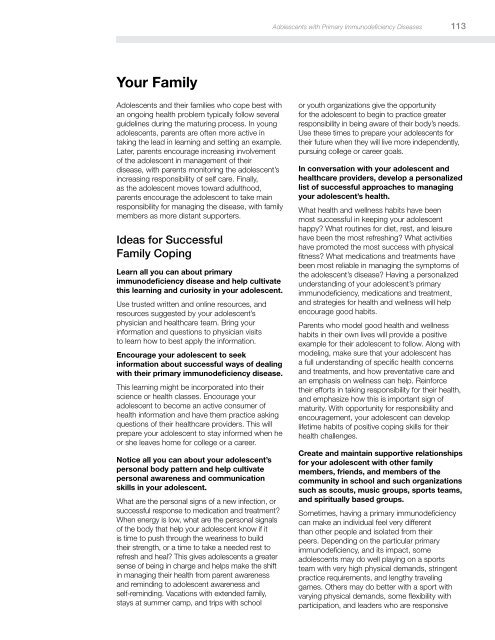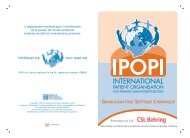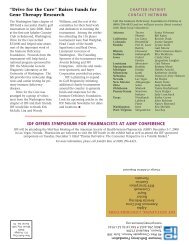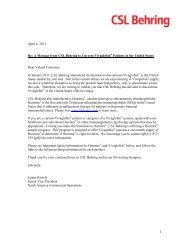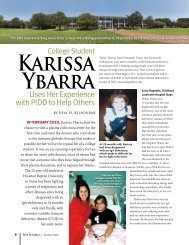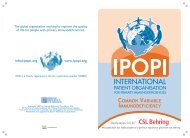IDF Patient & Family Handbook for Primary Immunodeficiency ... - IDFA
IDF Patient & Family Handbook for Primary Immunodeficiency ... - IDFA
IDF Patient & Family Handbook for Primary Immunodeficiency ... - IDFA
You also want an ePaper? Increase the reach of your titles
YUMPU automatically turns print PDFs into web optimized ePapers that Google loves.
Adolescents with <strong>Primary</strong> <strong>Immunodeficiency</strong> Diseases 113<br />
Your <strong>Family</strong><br />
Adolescents and their families who cope best with<br />
an ongoing health problem typically follow several<br />
guidelines during the maturing process. In young<br />
adolescents, parents are often more active in<br />
taking the lead in learning and setting an example.<br />
Later, parents encourage increasing involvement<br />
of the adolescent in management of their<br />
disease, with parents monitoring the adolescent’s<br />
increasing responsibility of self care. Finally,<br />
as the adolescent moves toward adulthood,<br />
parents encourage the adolescent to take main<br />
responsibility <strong>for</strong> managing the disease, with family<br />
members as more distant supporters.<br />
Ideas <strong>for</strong> Successful<br />
<strong>Family</strong> Coping<br />
Learn all you can about primary<br />
immunodeficiency disease and help cultivate<br />
this learning and curiosity in your adolescent.<br />
Use trusted written and online resources, and<br />
resources suggested by your adolescent’s<br />
physician and healthcare team. Bring your<br />
in<strong>for</strong>mation and questions to physician visits<br />
to learn how to best apply the in<strong>for</strong>mation.<br />
Encourage your adolescent to seek<br />
in<strong>for</strong>mation about successful ways of dealing<br />
with their primary immunodeficiency disease.<br />
This learning might be incorporated into their<br />
science or health classes. Encourage your<br />
adolescent to become an active consumer of<br />
health in<strong>for</strong>mation and have them practice asking<br />
questions of their healthcare providers. This will<br />
prepare your adolescent to stay in<strong>for</strong>med when he<br />
or she leaves home <strong>for</strong> college or a career.<br />
Notice all you can about your adolescent’s<br />
personal body pattern and help cultivate<br />
personal awareness and communication<br />
skills in your adolescent.<br />
What are the personal signs of a new infection, or<br />
successful response to medication and treatment?<br />
When energy is low, what are the personal signals<br />
of the body that help your adolescent know if it<br />
is time to push through the weariness to build<br />
their strength, or a time to take a needed rest to<br />
refresh and heal? This gives adolescents a greater<br />
sense of being in charge and helps make the shift<br />
in managing their health from parent awareness<br />
and reminding to adolescent awareness and<br />
self-reminding. Vacations with extended family,<br />
stays at summer camp, and trips with school<br />
or youth organizations give the opportunity<br />
<strong>for</strong> the adolescent to begin to practice greater<br />
responsibility in being aware of their body’s needs.<br />
Use these times to prepare your adolescents <strong>for</strong><br />
their future when they will live more independently,<br />
pursuing college or career goals.<br />
In conversation with your adolescent and<br />
healthcare providers, develop a personalized<br />
list of successful approaches to managing<br />
your adolescent’s health.<br />
What health and wellness habits have been<br />
most successful in keeping your adolescent<br />
happy? What routines <strong>for</strong> diet, rest, and leisure<br />
have been the most refreshing? What activities<br />
have promoted the most success with physical<br />
fitness? What medications and treatments have<br />
been most reliable in managing the symptoms of<br />
the adolescent’s disease? Having a personalized<br />
understanding of your adolescent’s primary<br />
immunodeficiency, medications and treatment,<br />
and strategies <strong>for</strong> health and wellness will help<br />
encourage good habits.<br />
Parents who model good health and wellness<br />
habits in their own lives will provide a positive<br />
example <strong>for</strong> their adolescent to follow. Along with<br />
modeling, make sure that your adolescent has<br />
a full understanding of specific health concerns<br />
and treatments, and how preventative care and<br />
an emphasis on wellness can help. Rein<strong>for</strong>ce<br />
their ef<strong>for</strong>ts in taking responsibility <strong>for</strong> their health,<br />
and emphasize how this is important sign of<br />
maturity. With opportunity <strong>for</strong> responsibility and<br />
encouragement, your adolescent can develop<br />
lifetime habits of positive coping skills <strong>for</strong> their<br />
health challenges.<br />
Create and maintain supportive relationships<br />
<strong>for</strong> your adolescent with other family<br />
members, friends, and members of the<br />
community in school and such organizations<br />
such as scouts, music groups, sports teams,<br />
and spiritually based groups.<br />
Sometimes, having a primary immunodeficiency<br />
can make an individual feel very different<br />
than other people and isolated from their<br />
peers. Depending on the particular primary<br />
immunodeficiency, and its impact, some<br />
adolescents may do well playing on a sports<br />
team with very high physical demands, stringent<br />
practice requirements, and lengthy traveling<br />
games. Others may do better with a sport with<br />
varying physical demands, some flexibility with<br />
participation, and leaders who are responsive


